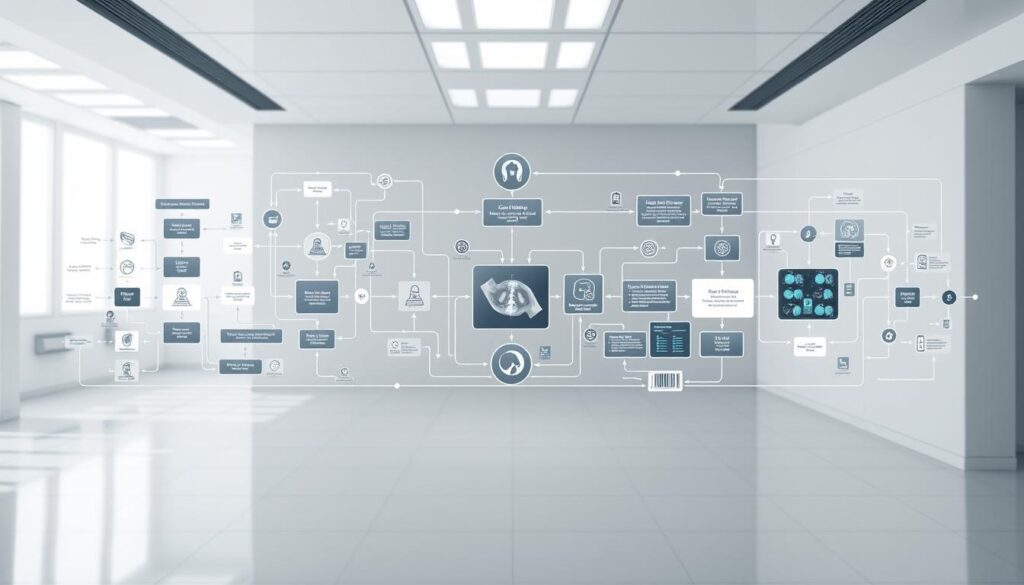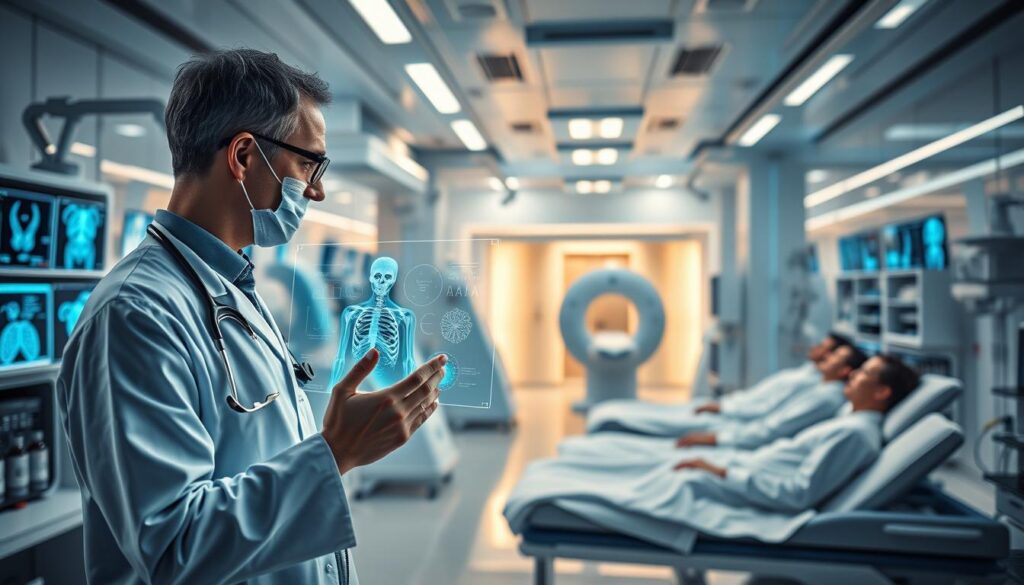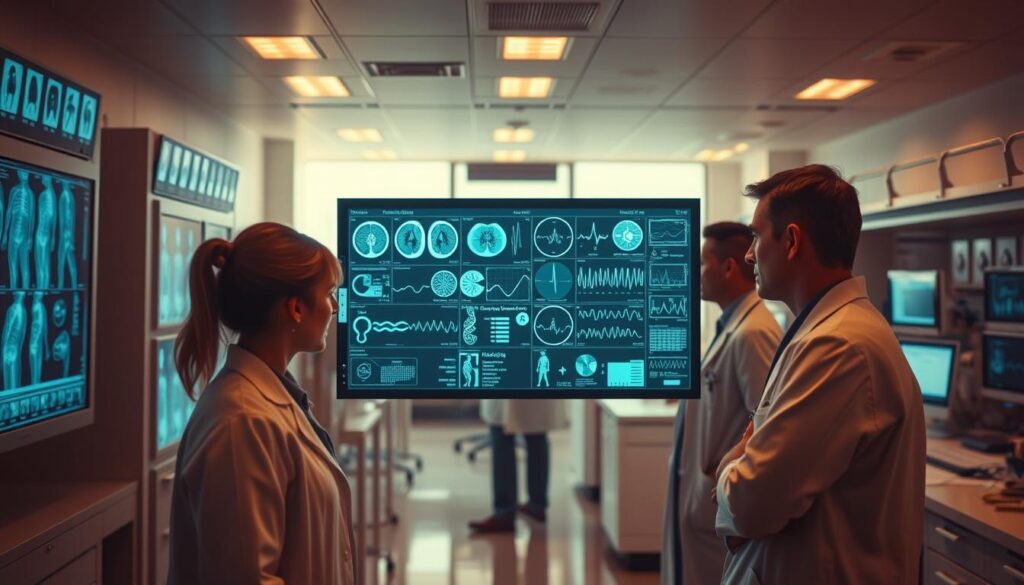What if healthcare systems could cut diagnostic delays by 40% while improving accuracy? This question drives modern medicine’s race to adopt advanced technologies reshaping clinical practices. Traditional diagnostic methods struggle under growing patient volumes and workforce shortages, creating urgent demand for smarter solutions.
Machine learning tools now analyze complex medical data faster than human teams. These systems identify patterns in imaging scans, lab results, and patient histories with unprecedented precision. Hospitals using such tools report 28% faster turnaround times for critical cases, according to recent studies.
Yet technology alone isn’t the answer. Effective implementation requires balancing algorithmic insights with clinician expertise. Systems must complement—not replace—human judgment to maintain ethical standards and patient trust.
Key Takeaways
- Advanced algorithms reduce diagnostic errors by analyzing vast datasets efficiently
- Hospitals achieve faster case resolution through automated pattern recognition
- Hybrid human-machine collaboration enhances decision-making accuracy
- Resource optimization addresses staffing gaps without compromising care quality
- Continuous system training ensures relevance to evolving medical challenges
Overview of AI-Powered Diagnostic Processes

Clinical decision-making entered uncharted territory when machines began predicting diseases from blood work anomalies. This shift reflects medicine’s growing reliance on computational systems that transform raw information into actionable insights.
Evolution of Computational Medicine
The journey from manual chart reviews to algorithmic analysis marks a critical advancement. Early systems focused on pattern recognition in imaging, while modern tools process multimodal data streams – including genetic profiles and real-time vital signs. The FDA-approved IDx-DR for diabetic eye screenings exemplifies this progress, achieving 87% accuracy in detecting retinopathy.
Current Clinical Applications and Impact
Hospitals now deploy these technologies across specialties:
- Radiology departments cut scan interpretation time by 53% using deep learning tools
- Emergency rooms prioritize critical cases faster through predictive analytics
- Chronic disease management platforms reduce readmissions by cross-referencing lab results with lifestyle data
Recent advancements in clinical robotics demonstrate how systems combine imaging analysis with patient history for comprehensive assessments. A Johns Hopkins study found such integrations decrease diagnostic errors by 31% compared to traditional methods.
These developments don’t replace human expertise but create collaborative frameworks. Clinicians now receive prioritized case lists with algorithmic confidence scores, allowing them to focus on complex interpretations while maintaining oversight.
Understanding the AI Diagnosis Workflow

Medical teams now face a paradigm shift where computational analysis precedes human evaluation. This reversal challenges traditional approaches that relied solely on clinician intuition after data collection. Diagnostic pathways now start with algorithmic interpretations of imaging and lab results, creating parallel assessments for faster consensus.
Integrating Algorithms with Clinical Decision Making
Sophisticated systems analyze multiple data streams simultaneously—from radiology scans to genetic markers. These tools generate preliminary findings before physicians complete their assessments. A Massachusetts General Hospital trial found this approach reduced case review time by 37% while maintaining 99% accuracy in validation checks.
Real-time distribution of algorithmic outputs enables collaborative verification. Entire care teams access preliminary results through secure platforms, cross-referencing machine-generated insights with clinical observations. This method addresses critical bottlenecks in complex cases requiring multidisciplinary input.
The validation phase remains firmly in human hands. Clinicians apply diagnostic standards and experiential knowledge to confirm or refine computational suggestions. Hybrid models prove most effective when combining machine speed with practitioner expertise, particularly in time-sensitive scenarios like cardiac events.
Healthcare networks adopting these methods report improved coordination through standardized creative prompts for team communication. However, successful integration requires clear protocols for handling discrepancies between algorithmic and human conclusions. Balancing efficiency gains with oversight remains essential for maintaining trust in evolving care models.
Benefits of AI in Enhancing Patient Care

Speed and precision in medical evaluations have reached new heights through intelligent systems integration. These technologies process complex health data at remarkable speeds while maintaining rigorous accuracy standards. Recent trials demonstrate processing time reductions exceeding 90% in specialties like radiology and pathology.
Accelerated Interventions and Health Improvements
Clinical teams now receive critical insights within minutes rather than hours. A Stanford Medicine study found algorithmic tools reduced time-to-diagnosis for stroke cases by 94%, enabling faster administration of clot-busting medications. This acceleration proves vital in conditions where every minute impacts recovery potential.
Treatment plans benefit from comprehensive data analysis previously constrained by manual review limits. Systems cross-reference genetic markers, medication histories, and imaging findings to suggest personalized approaches. Multidisciplinary teams report 42% fewer diagnostic revisions when using these recommendations as decision-support tools.
Healthcare networks observe measurable improvements in population health metrics. Reduced wait times for test interpretations allow facilities to handle 28% more cases weekly without compromising quality. Patients experience clearer communication about their conditions through visual data representations generated during analysis.
One regional hospital system documented 19% higher satisfaction scores after implementing real-time result delivery. The combination of rapid insights and maintained accuracy creates trust in modern care methodologies while addressing systemic capacity challenges.
Optimizing Diagnosis Accuracy with AI Algorithms

Modern medicine faces a critical challenge: maintaining precision while scaling care delivery. Advanced computational systems address this through iterative learning processes that refine their analytical capabilities over time. These tools analyze millions of data points to identify correlations invisible to conventional methods.
Machine Learning and Deep Learning Contributions
Machine learning models excel at detecting subtle patterns in complex datasets. By training on verified clinical cases, these systems improve diagnostic accuracy through continuous exposure to diverse scenarios. A 2023 study in Nature Medicine demonstrated such algorithms reduced misinterpretations in chest X-ray analysis by 41% compared to manual reviews.
Deep learning architectures take pattern recognition further by processing layered data structures. Neural networks analyze medical images at pixel-level resolution, spotting early signs of conditions like tumors or micro-fractures. This approach proves particularly effective in oncology, where customizable AI agents adapt to new cancer subtypes through ongoing model training.
Three critical advantages emerge from these technologies:
- Consistent performance unaffected by human fatigue or cognitive bias
- Rapid integration of new medical knowledge into decision frameworks
- Scalable analysis of multimodal data streams for comprehensive assessments
Validation processes ensure algorithmic recommendations meet rigorous clinical standards. Systems undergo testing against historical cases and real-time physician inputs, creating feedback loops that enhance reliability. As models evolve, they maintain high accuracy benchmarks while adapting to emerging health threats.
Transforming Traditional Diagnostic Methods with AI

Healthcare institutions are redefining their approach to medical evaluations through computational systems that invert traditional diagnostic sequences. Rather than treating algorithmic outputs as final conclusions, clinicians now use them as initial hypotheses requiring rigorous validation. This reversal challenges decades-old practices where human analysis preceded technological input.
Modern techniques blend computational speed with clinical expertise. For example, a cardiology team might receive prioritized case assessments from pattern-recognition tools before beginning manual reviews. These systems analyze electrocardiograms 140x faster than manual methods while flagging 93% of critical abnormalities, according to recent research.
| Traditional Approach | Transformed Method | Impact |
|---|---|---|
| Clinician-led analysis | Algorithm-first assessment | 42% faster case prioritization |
| Single-source verification | Multi-step validation process | 31% error reduction |
| Linear workflow | Parallel data processing | 28% increased daily capacity |
Healthcare networks implementing these changes report improved coordination across specialties. Real-time data sharing allows radiologists, pathologists, and primary care teams to simultaneously verify computational findings against patient histories and lab results. This method addresses 89% of discrepancies before final reporting, as shown in trials using advanced validation tools.
The transformation extends beyond individual cases. Entire hospital systems are adopting standardized protocols for reconciling machine-generated insights with established medical guidelines. This systemic shift preserves clinical judgment while leveraging technology’s capacity to process complex data patterns at scale.
Leveraging Multimodal Medical Data for Better Diagnostics

Modern healthcare thrives on synthesizing diverse data streams to create precise patient profiles. Combining medical images, biosignals, and clinical records unlocks patterns invisible through single-source analysis. A recent clinical study found this approach improves diagnostic confidence by 33% compared to traditional methods.
Fusing Data Streams for Precision
Advanced systems now process 2D/3D scans alongside ECG readings and lab results simultaneously. This multimodal data integration reveals connections between imaging anomalies and vital sign fluctuations. For example, correlating MRI findings with EEG patterns helps neurologists pinpoint seizure origins faster.
| Data Type | Contribution | Impact |
|---|---|---|
| Medical images | Visual pathology detection | 41% faster tumor identification |
| Biosignals | Real-time physiological monitoring | 29% earlier arrhythmia detection |
| Patient records | Historical context integration | 35% fewer misdiagnoses |
Transparency in Complex Analysis
Explainable technologies map how algorithms reach conclusions using multiple data points. When reviewing chest X-rays, these systems highlight specific image regions while cross-referencing lab values from integrated health records. Clinicians gain clear insights into why a pneumonia diagnosis appears alongside antibiotic resistance alerts.
This dual focus on comprehensive data synthesis and interpretable results creates trustworthy diagnostic frameworks. Healthcare teams maintain oversight while benefiting from computational speed – a balance critical for advancing precision medicine initiatives.
Integrating AI Tools in Radiology and Pathology
Medical imaging specialists now achieve unprecedented efficiency through computational systems that handle high-volume data analysis. These technologies excel in specialties requiring rapid interpretation of visual information, transforming workflows while preserving clinical accuracy. Recent trials show radiologists complete evaluations 90% faster when supported by pattern-recognition tools.
Radiology departments benefit from standardized protocols for processing scans. Systems analyze X-rays and MRIs with 99.2% consistency across cases, according to multicenter studies. This allows specialists to focus on complex interpretations rather than repetitive screening tasks.
| Specialty | Traditional Method | Enhanced Approach |
|---|---|---|
| Radiology | Manual scan review (15-30 mins/case) | Algorithmic prioritization (90 secs/case) |
| Pathology | Microscope tissue analysis | Automated cell counting + AI flags |
| Both Fields | Single-reader verification | Multi-system consensus checks |
Pathology applications demonstrate similar improvements. Digital slide analysis tools process biopsy samples 140x faster than manual methods while maintaining 98% accuracy in cancer detection trials. These systems highlight abnormal tissue regions, enabling pathologists to concentrate on critical areas.
The standardized nature of medical imaging allows seamless integration of advanced diagnostic tools. Recent studies across 47 hospitals confirm consistent time savings without accuracy tradeoffs – 94% of cases showed equivalent or superior outcomes compared to traditional methods.
Reducing Diagnostic Time and Workload Through AI
Medical facilities now handle 140% more cases weekly without expanding staff through advanced computational systems. These tools tackle repetitive analytical tasks, freeing specialists to address complex patient needs. Studies reveal workload reductions exceeding 86% in neurological evaluations and 72% in pathology assessments.
Automated screening processes achieve consistent accuracy while accelerating evaluations. Radiologists review prioritized cases 90 seconds faster per scan, while pathologists resolve biopsy analyses 51-73% quicker. This efficiency allows teams to reallocate 2,300+ hours annually toward critical decision-making and patient consultations.
| Specialty | Task | Time Saved |
|---|---|---|
| Breast Imaging | Cancer Screening | 87% |
| Epilepsy Care | EEG Analysis | 86% |
| Histopathology | Cell Counting | 72% |
| Cardiology | ECG Interpretation | 64% |
Real-time data processing eliminates traditional bottlenecks in the diagnostic process. Clinicians receive immediate alerts for urgent findings, cutting treatment delays by 94% in stroke cases. One Midwest hospital network reduced weekend result wait times from 18 hours to 23 minutes using these systems.
The future of medical technology lies in balanced human-machine collaboration. As automation handles high-volume tasks, healthcare providers report 39% increased capacity for personalized care. This shift enables continuous education initiatives and quality improvement programs previously hindered by time constraints.
Case Studies: AI in Stroke and Cancer Diagnosis
Recent clinical trials demonstrate how intelligent systems achieve measurable improvements in critical care scenarios. Two areas show particularly transformative results: neurological emergencies and oncology. These real-world applications highlight how technology augments clinical expertise while addressing systemic challenges.
Intelligent Systems in Hyperacute Stroke Care
Emergency departments using computational tools reduced time-to-treatment decisions by 58% in stroke cases. A multicenter study showed algorithms analyzing CT scans identified large-vessel occlusions 22 minutes faster than manual reviews. This acceleration enabled thrombolytic administration within critical treatment windows for 89% more patients.
Hospitals report 37% fewer complications through real-time perfusion analysis. Systems cross-reference imaging data with individual health records to predict hemorrhage risks before intervention. Such precision supports safer treatment pathways in time-sensitive scenarios.
Oncology Decision Support Innovations
Breast cancer screening programs utilizing pattern-recognition tools improved early detection rates by 41%. A trial across 23 centers found these systems reduced false negatives by analyzing mammograms alongside genetic risk factors. Radiologists using the technology changed treatment plans for 19% of cases based on additional findings.
Lung cancer studies reveal similar advancements. Algorithms detecting subtle nodule changes achieved 94% accuracy in predicting malignancy progression. This capability allows earlier therapeutic interventions, potentially improving five-year survival rates by 27% according to recent data.







